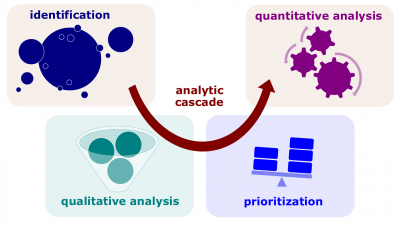Analytic cascade
Analytic cascade (hereinafter, the Cascade) is a model used to analyze uncertain factors such as risks, targets, concepts, sources, data, etc. These factors are identified first, qualitatively analyzed second, prioritized third, selected to be further analyzed fourth, and those, that are selected as the most important ones, quantitatively analyzed fifth.
Stages
- Uncertain factor identification. Determining which risks might affect the project and documenting their characteristics. Tools used include brainstorming and checklists.
- Uncertain factor prioritization. The process that arranges proposed changes in order of importance relative to each other based on a review of the means available and the impact of trade-offs to attain the objectives.
- Qualitative analysis. Performing a qualitative analysis of risks and conditions to prioritize their effects on project objectives. It involves assessing the probability and impact of project risk(s) and using methods such as the probability and impact matrix to classify risks into categories of high, moderate, and low for prioritized risk response planning.
- Prioritization. The process of determining the relative importance of a set of items in order to determine the order in which they will be addressed.
- Quantitative analysis. Measuring the probability and consequences of risks and estimating their implications for project objectives. Risks are characterized by probability distributions of possible outcomes. This process uses quantitative techniques such as simulation and decision tree analysis.
